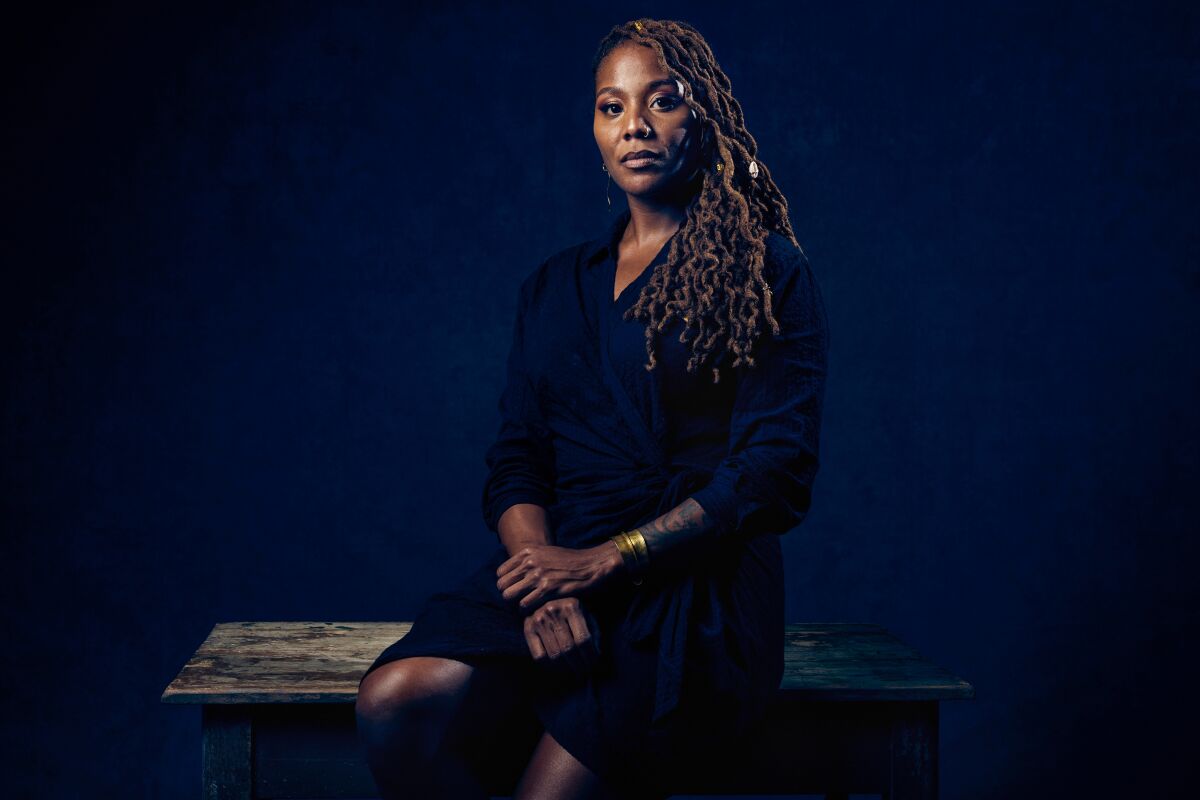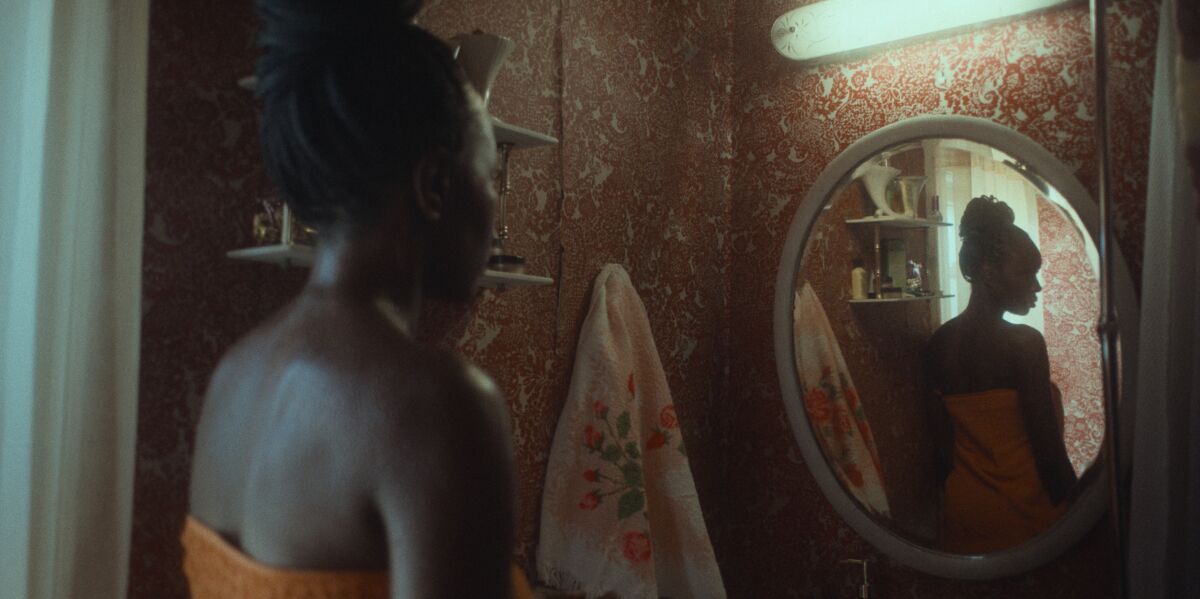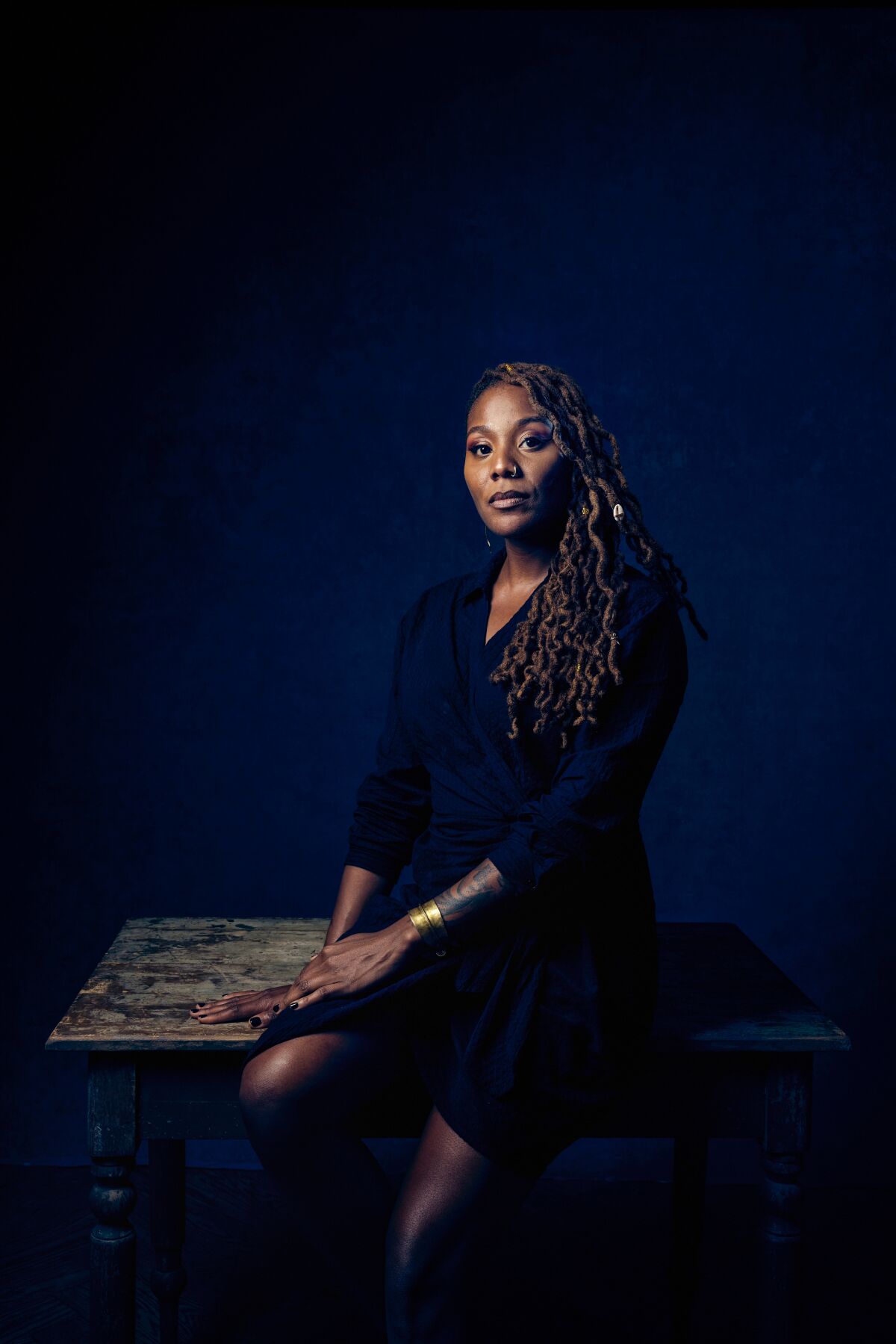
“Nanny” filmmaker Nikyatu Jusu in the Los Angeles Times photo studio at RBC House during the Toronto International Film Festival in September.
(Kent Nishimura / Los Angeles Times)
“How do you use your rage?”
Both reminder and affirmation, this impactful question comes from writer, director and scholar Nikyatu Jusu’s feature debut, “Nanny,” in theaters Nov. 23 and on Prime Video Dec. 16. Winner of the Grand Jury Prize at the 2022 Sundance Film Festival, the film follows Aisha (Anna Diop), an undocumented Senegalese woman who works as a nanny for an affluent, white family, with hopes of bringing her son — whom she has had to leave behind in her home country — to New York.
Aisha is tasked not only with childcare, but also with navigating a gamut of microaggressions from Amy, her charge’s ever-watchful, controlling mother and father Adam, a photojournalist who trades in capturing images of racialized people fighting for liberation. Between Adam’s fetishistic gaze and Amy’s misguided projections of gender solidarity, the pair underscores the unacknowledged labor all too often demanded of Black women.
As in her celebrated 2019 short, “Suicide by Sunlight,” Jusu exhibits an intuitive understanding of the violence of words, images and actions — and of why the indignities of gendered anti-Blackness can so easily lend themselves to horror filmmaking.
Ahead of “Nanny’s” premiere at TIFF earlier this year, The Times spoke with Jusu about crafting stories from ephemeral histories, the kaleidoscopic nature of Blackness, and the figures who have unmistakably influenced the director’s desire to create new worlds.
I was struck by the way you witness Aisha’s experience without encroaching on her interior life. I’m thinking, for example, of your use of images of Aisha recorded through surveillance cameras — there is violence to those acts of imagemaking, but your use of them doesn’t compromise her autonomy as a character. How did you find harmony between those realities?
For me, it’s very organic in terms of the way that I move through the world in my body and the way that I see the world. I’m lucky in the sense that I’m able to be as honest a filmmaker as I am and still be supported. That’s rare. I couldn’t see it being any other way — it’s the only way I know how to be. I’m grateful to be able to stay true to myself and progress in my work, although I probably would’ve been able to progress faster had I not been who I am.
There’s a proverb — it’s very African — about a centipede and a monkey; the monkey asks the centipede “How do you move around on all of those legs?” and the centipede answers “I never thought about it.” After being asked that question, suddenly the centipede starts tripping over its own legs. I’m constantly navigating being hyper-aware of my process versus that process happening inherently and innately.
As someone with immediate Sierra Leonean ancestry, you’re uniquely positioned in that you are both West African and also a Black American. I’m wondering how you instilled your film with the understanding that comes from that experience?
In “Nanny,” and most of my work, one of my goals is to explore the Black diaspora — to have Africans of different nations colliding, intersecting and melding with Black Americans. Because that’s the reality that I have experienced myself. I grew up in a household that was very rich in terms of its span of Black diasporic life. I had aunts and uncles from Trinidad, Ghana, Liberia and Philly. It was a confluence of Blackness. We are a vast multitude of people, and I don’t see often see [that] reflected in the media.
When Africans come here, they learn a hard lesson about Blackness. Nobody cares to know about your tribe, your region or your nation. I straddle those worlds, the disconnect between African and Black American histories. To show the ways that we share culture and tradition is a goal for me. It’s not just about the way we are oppressed — Blackness can often be flattened in that way — although that is, of course, important to speak to. It’s something that I’m constantly making sense of, what it means to be who I am here.

Anna Diop in “Nanny.”
(Prime Video)
The way that you engage with haunting, violence and grief in your film is so impactful, especially since, alongside that, you maintain that there remains a capacity for pleasure. There is a warmth “Nanny” brings to the moments of intimacy and love that feels very lived — it’s a way of filmmaking that shapes not only Aisha’s life onscreen, but how we as Black audiences, especially Black women and femmes, are affected by the film. It’s an act of care as a writer and director to work in such an intentional way.
In recent interviews, Jordan Peele has spoken of the disproportionate burden of Black directors working in horror. Those of us who understand the conventions of the genre know that there has to be conflict, there has to be trauma, and often both of those things are relentless. Because my protagonist is a Black woman and because I’m cognizant of how Black women have been conveyed in motion pictures — the lack of care that they are given — it’s important to me to have that balance of light and dark.
This balancing act or juxtaposition, which we see most often outside of the American cinematic canon, gives me permission to make my work more than just one thing. Directors like Park Chan-wook, Lynne Ramsay, Ousmane Sembène and Safi Faye —their work affirms this. A lot of people in this industry are not watching films made outside of the American paradigm, and that was a hard lesson for me to learn, especially coming out of both an academic and artistic background. Working in this industry now, I have meetings with executives that are paid very well not to watch foreign cinema.
The end of your film sees an undoing or collapsing of what are very Western conceptions of time and space. It’s a disruption that gestures toward the potential of decolonizing the genre as well as the nonlinear sphere of the ancestral. I think there’s a way that Black women and Black nonbinary folks make and receive art that acknowledges what came before. It’s a way of approaching art with our ancestors in hand.
Saidiya Hartman and Toni Morrison are both people who have permitted me to do that in this way. They both stand out to me as women who [were and] are exploring what it means to articulate time and timelessness in a medium, what it means to simultaneously traverse the past, present and future. That is an understanding that is prevalent in our oral tradition, in my parent’s tribal traditions — at least, precolonialism. We have to hunt for permissions like this to undertake storytelling in this intuitive way that we have been removed from in our current culture and society; it’s seen as confusing or too abstract.
In most of the interviews that I’ve done — largely with white men — in this industry, I can tell that, as cinephiles, they’re excited about the way that I’ve executed the film. I knew, going into filmmaking — like every other thing I’ve done in my life — I would have to do it excellently or be picked apart by people eager to do so. So, these people I’m talking with, they can tell that the lighting is great or that the cinematography is great — basically, anything that can be ascribed to something outside of myself. But in terms of these elements you and I are speaking of, they don’t get it.
I look to people like Ousmane Sembène when I think about timelessness. How [his film] “Black Girl” [showed] us a woman who lives in memory shards. Those memory shards are a big thing in my work; making peace with that as something inherent to me is important to me.

“By the very nature of surviving and existing in these systems that have burned down all of our archives, we are storytellers,” Jusu says.
(Kent Nishimura / Los Angeles Times)
My instinct is to place you within this canon, alongside writers like Morrison and films like Kasi Lemmons’ “Eve’s Bayou” and Sembène’s “Black Girl.” I say this not to minimize your agency as a filmmaker or reduce your work to identity markers, but rather to speak to art that is working with these ideas of space and time as a kind of memory work and grief work.
You’re also making me think of Yaa Gyasi’s [novel] “Homegoing” and how so much of my entry point into storytelling was being a voracious reader when I was younger. I grew up with a mother who self-published her work, and novels were coming in and out of that space all of the time. I think there’s more freedom in the novelistic form to play with these things that we’re talking about, so I’m constantly trying to figure out how to make a novel in a motion picture.
How do you see the figure of Aisha’s spectral self in the film? I’m thinking of her self-haunting in relation to West African myth — these moments where it felt like reality was taken over by something otherwise.
The figure of Mami Wata is complicated. In the American context, “Nanny” is one of the few films that has taken on Mami Wata in live-action — it’s something you need a budget to execute in the way that you want to. I’m a researcher, to a fault, and JSTOR was an invaluable resource because it’s hard to find information about these things that have been largely translated and passed down orally. I wanted to couch Mami Wata, as much as I could, in Sierra Leonean tradition because, at the end of the day, that is my lineage. But the knowledge available through [these means] can be sparse, so I had to piece together many figures — water entities — from other different cultures, like La Siréne from Haiti or Yemọja from the Yoruba.
A lot of what I gathered from these different iterations of Mami Wata was the importance of reflective surfaces. That became a motif that allowed us to understand the ways that Aisha was changing throughout the film. Both Anansi and Mami Wata are figures who are forcing her to step into her power. In this way, I’m ascribing to the paradigms that audiences understand in terms of structure, but I’m also weaving in these entities that are outside of it.
Taking from different sources as a means of making up for absent or inaccessible histories is something that I think much of the Black diaspora experiences. That process is a way of placemaking.
You have to take liberties with the archives sometimes. Hartman is someone who taught me about being a storyteller even as we are reflecting truthful histories because we’ve lost so much and so much has been denied of us. By the very nature of surviving and existing in these systems that have burned down all of our archives, we are storytellers.
Stay connected with us on social media platform for instant update click here to join our Twitter, & Facebook
We are now on Telegram. Click here to join our channel (@TechiUpdate) and stay updated with the latest Technology headlines.
For all the latest Hollywood News Click Here
